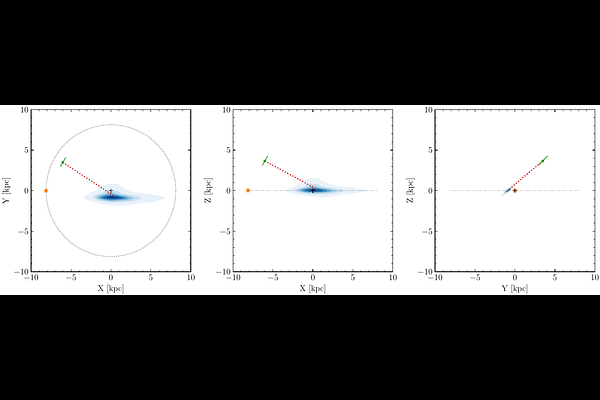Spectroscopic and kinematic analyses of a warm survivor of a D6 supernova

Spectroscopic and kinematic analyses of a warm survivor of a D6 supernova
Mark A. Hollands, Ken. J. Shen, Roberto Raddi, Boris T. Gaensicke, Evan B. Bauer, Alberto Rebassa-Mansergas
AbstractSDSSJ163712.21+363155.9 is a candidate hyper-runaway star, first identified from its unusual spectrum in the Sloan Digital Sky Survey, which exhibits oxygen, magnesium, and silicon lines redshifted by several $100\,$km/s, leading to the suggestion it was ejected from a thermonuclear supernova. We have acquired GTC OSIRIS spectroscopy of SDSSJ1637+3631 establishing a warm ($T_\mathrm{eff}=15680\pm250\,$K) carbon+oxygen dominated atmosphere, that is also abundant in the intermediate mass elements silicon, sulphur, and calcium. We interpret SDSSJ1637+3631 as the donor to an accreting white dwarf that exploded in a dynamically-driven double-degenerate double-detonation (D6) type Ia supernova, where the current composition is consistent with a CO white dwarf core, enriched with intermediate mass elements from deposited supernova ejecta. While SDSSJ1637+3631 has a low-precision Gaia parallax, our spectroscopic surface gravity ($\log g=6.3\pm0.3\,$dex) helps constrain its tangential velocity to $1950^{+810}_{-530}\,$km/s, providing additional support to the D6 mechanism. Under the assumption that SDSSJ1637+3631 is a D6 survivor, we construct a kinematic model combining all astrometric, spectroscopic, and photometric information, but also including the structure and gravitational potential of the Milky Way. Our model localises the ejection site to the inner few kpc of the Galactic disc (though excluding the Galactic centre), with an ejection speed of $1870^{+360}_{-300}\,$km/s, and a $4.5^{+0.4}_{-0.5}\,$Myr time of flight.